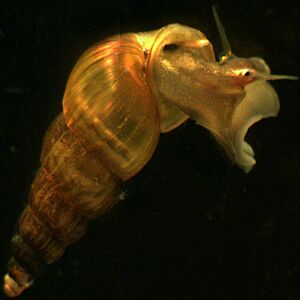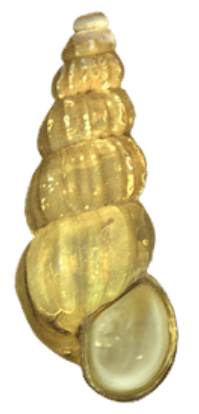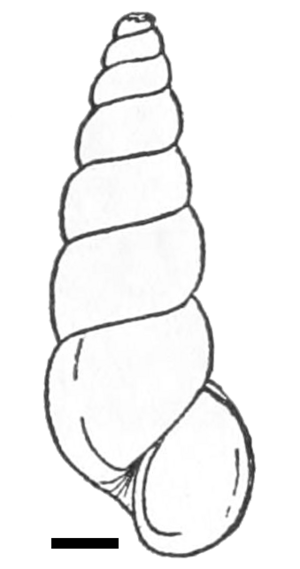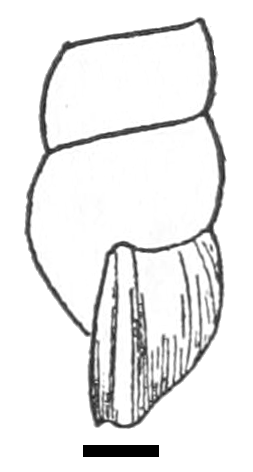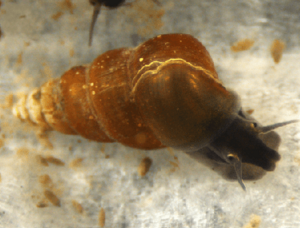Oncomelania hupensis facts for kids
Quick facts for kids Oncomelania hupensis |
|
|---|---|
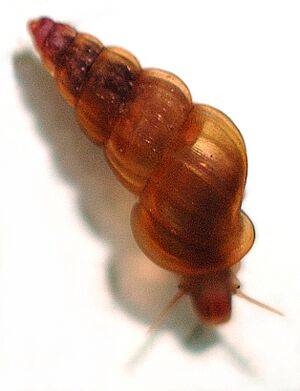 |
|
| Scientific classification |
Oncomelania hupensis is a very tiny freshwater snail. It's a type of water animal that belongs to a group called gastropod mollusks. These snails live in warm, tropical places.
Contents
Where These Snails Live
Oncomelania hupensis snails can be found in several countries in Asia. They live in China, Taiwan, and also in Japan. You can also find them in the Philippines and on the Indonesian island of Sulawesi.
What They Look Like
For many years, scientists have discussed how to group Oncomelania hupensis because their shells and other body parts can look different.
These snails can have two main types of shells:
- Ribbed shells: These shells have ridges, like tiny bumps or lines. In China, most Oncomelania hupensis snails found in the Yangtze River area have ribbed shells.
- Smooth shells: These shells are smooth, without any ridges. Smooth-shelled snails are also found in China.
Snails of this species found in other parts of Asia, like Japan and the Philippines, usually have smooth shells. Scientists sometimes consider these to be slightly different types, or subspecies, of Oncomelania hupensis.
Different Types of Oncomelania hupensis
Scientists divide Oncomelania hupensis into several different types, called subspecies. These subspecies often live in different places and can have slightly different features.
Here are some of the known subspecies:
- Oncomelania hupensis chiui (Habe & Miyazaki, 1962)—found in Taiwan.
- Oncomelania hupensis hupensis (Gredler, 1881)—found in China. This is the most common type. It usually lives in low areas near the Yangtze River, but some live in hilly places. Most of these snails have ribbed shells.
- Oncomelania hupensis formosana (Pilsbry & Hirase)—found in Taiwan.
- Oncomelania hupensis guangxiensis (Liu, 1981)—found in the Guangxi region of China.
- Oncomelania hupensis lindoensis (Davis & Carney, 1973)—found on the island of Sulawesi, or sometimes seen as its own species, Oncomelania lindoensis.
- Oncomelania hupensis nosophora (Robson, 1915)—this type is endangered in Japan, meaning it's at high risk of disappearing.
- Oncomelania hupensis quadrasi (Möllendorff, 1895)—found in the Philippines.
- Oncomelania hupensis robertsoni (Bartsch, 1946)—found in the Sichuan and Yunnan provinces of China. It has a small, smooth shell.
- Oncomelania hupensis tangi (Bartsch, 1936)—found in the Fujian province and Guangxi region of China. This type has a smooth shell. Efforts to control these snails have made them very rare.
In China, there are four main subspecies: hupensis, robertsoni, tangi, and guangxiensis. Scientists study their DNA to confirm these different types.
Snail Genetics
Scientists believe that ongoing efforts to control these snails, like using special chemicals for about 50 years, might have changed the snails' population genetics. This means the way their genes are passed down through generations might be different now.
In 2010, scientists were able to map out the complete mitochondrial genome of Oncomelania hupensis. This is like having a full instruction manual for a part of the snail's DNA.
Where They Live and How They Survive
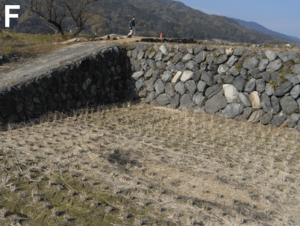
Oncomelania hupensis is a species that can live both in water and on land, depending on the season. They live in lakes and on wet, marshy ground.
In the middle and lower parts of the Yangtze River, these snails live in areas with lakes and marshes, as well as in hilly regions. These places are often connected to the Yangtze River by channels or are in low areas that flood easily. When the Yangtze River floods often, snails can be spread far and wide to new places. This mixing of snails from different areas can lead to many different types of snails with varied genetic makeups.
In the Sichuan and Yunnan provinces, which are higher up the Yangtze River, the Oncomelania hupensis robertsoni subspecies lives in mountains. These areas don't get flooded as much. Scientists have found fewer genetic variations in these mountain snails compared to the Oncomelania hupensis hupensis found in the lower river areas. This suggests that the mountain snail populations might be more isolated from each other.
Snails and Health
These tiny freshwater snails are very important for human health, especially in tropical and subtropical areas. This is because they can act as a vector, meaning they can carry and spread tiny parasitic worms that cause serious diseases in people.
Oncomelania hupensis is the only snail that can carry the Schistosoma japonicum parasite. This parasite causes a disease called schistosomiasis, which is common in the Far East, especially in mainland China. The presence of Oncomelania hupensis snails largely determines where this disease can spread. For example, after getting rid of Oncomelania hupensis snails, Japan was able to completely stop the spread of Schistosoma japonicum.
These snails can also carry another type of parasite called paragonimus, which causes lung fluke infections.
See also
- Oncomelania hupensis quadrasi is another name for Oncomelania quadrasi (Davis, 1968). This snail is found only in the Philippines.


